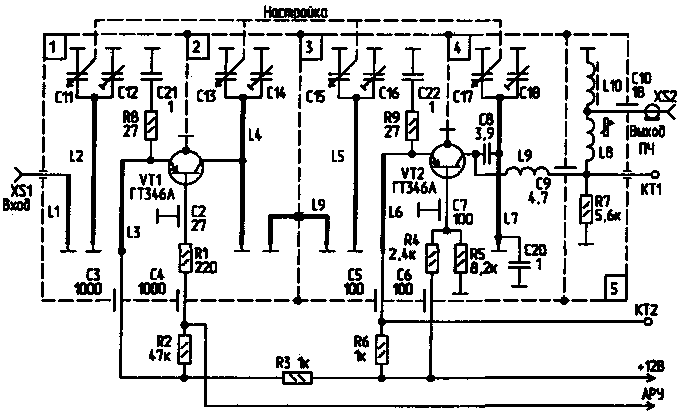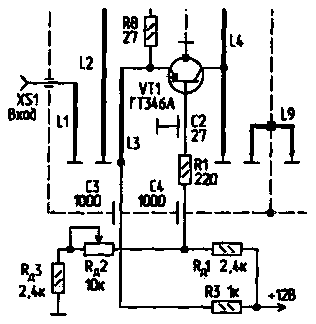Lately there are more and more TV stations operating in the UHF bands. Their power is relatively small, and therefore the admission of such stations is very difficult.
In many cases, helps the installation of UHF amplifiers. The broadband amplifier is not always an option, especially if there is a powerful transmitter, and you "hunt" for a remote TV station. And to build such an amplifier is far from easy. Anyone who has ever tried to make a similar device, knows that is not always the result lives up to expectations.
Obviously, in this case it is best to use the amplifier with tunable to the desired frequency response range. The use of such amplifier can significantly improve the reception of UHF stations due to the high selectivity of the cascades. However, the construction of this amplifier is suitable only for very experienced hams that have the ability to use the necessary measuring devices.
And what about those hams who are unable to purchase the necessary components that do not have the necessary measuring devices? However, the solution in this situation is simple - it is the use of ready-made industrial sites manufacture available for Amateurs.
The basis was taken the unit SC-D-1, which was used in tube-semiconductor TVs. Simple rebuilding that even a novice ham radio operator, allows you to receive UHF amplifier with good performance.
Operational characteristics UHF:
- Frequency range (21 to 60 channels), MHz 470...790;
- Gain, 20 dB;
- Frequency response, dB 4;
- The voltage, V +12 P;
- Consumption current, mA 15
The advantages of this amplifier include high selectivity and a significant suppression of interference on adjacent channels. There is a drawback - the need for restructuring (turning rotor) when switching to another channel. However, if receiving a message on one channel UHF, there is no need to restructure.
In Fig.1 shows the original block diagram of SC-D-1, and in Fig.2 - diagram of the SC-D-1 after the alteration, i.e. the scheme is the actual amplifier.

Fig.1
Consider the original block diagram of SC-D-1 (Fig.1). In the first chamber, there is a cascade transistor VT1 (ABOUT). The resonator L1 provides matching entry with the antenna L2 with capacities C and C12 form a tunable input circuit to tune to the desired channel. The collector of transistor VT1 is loaded on the contour L4-C13-C14, which is located in the second chamber. Next the signal goes to the contour L5-C15-C16, located in the third chamber. The inductor L6 signal reaches the emitter of the transistor VT2. On the VT2 transistor is assembled converters RF signal into the if TV. Transistor VT2 is connected to the circuit of capacitive treatacne, load cascade is L9, which, together with C17, C18, C8, L7, C20 is located in the fourth chamber.

Fig.2
Alteration of SC-D-1 is as follows:
- since in normal operation the first cascade transistor VT1 is controlled by the AGC system, TV receiver, you must set the operating mode without automatic gain control;
- translate the second cascade transistor VT2 mode conversion in a mode of amplification.
Getting started, remember that to handle the unit carefully, because the slightest change in the arrangement of parts when careless disassembly can cause detuning of the resonant circuits with circuits.
So, by removing the spring bar at the top of the cover, gently remove the cover. Account cameras (there are only 5) are conducted, ranging from jacks antenna input.
Inspect the internal wiring. Inside should be no obvious damage - burnt and broken resistors, capacitors. As the knob Vernier mechanism the movement of the plates Quad capacitor should be free, without circuit plates among themselves or with other elements. When working with the unit, you cannot change the position of the tuning capacitor, made in the form of silvered plates and located in front of the variable capacitor sections and resonance lines, made in the form of silver-plated tires and lengths of wires.
Gently vypayayte the following elements:
- C8, C20, L9, located in the 4th chamber;
- L8, L10 and R7, located in the 5th cell. The resistor R7 in some instances, the SC-D-1 may be absent.
Next, you need to determine the brand of transistors that are available in this block, SC-D-1. The fact that instead of transistors indicated in the diagram (Fig.1), there may be other, for example AF-239 and AF-139, which are analogs of transistors GTA and GTB respectively. If the VT2 transistor installed GTB or AF-139, it will have to remove and replace GTA. Transistors of this type are used in almost all the blocks of SK-D, as well as in blocks SC-M with electronic tuning, so that, in principle, to find such a simple transistor. Before you install a new transistor needs to be checked. If the check will be made with an ohmmeter, it should be remembered that the voltage of the ohmmeter may exceed the permissible reverse voltage of the emitter junction. Therefore, determining the serviceability of a transistor with an ohmmeter, you should not use the low-impedance limits ohmmeter. If there is a choice of several transistors, you should choose a transistor with possible large value h21e.
Before installing the transistor need a General conclusion ("corps") to connect by soldering with the body of the transistor. Above the camera window, which is a transistor, can be cut thin silver-plated wire. This segment is the "tail" L6. Therefore, in no case do not try to remove it by desoldering. Due to heating up subject to change position L6 in space that will lead to the detuning of the circuit. To remove the "tail" you need sidecutters. Cabinet output transistor VT2 can be put in a small hole that is available under the resistor R8, and to unsolder it from the 4th camera. The output header to be soldered to the same point on L7, which was soldered to the output of the seized transistor.
Carefully solder the findings of the emitter and base without overheating the solder points, as in places rations are small capacitors that overheating can break down. Next, you need to remove the resistors R6 and R4, thus disabling the second cascade from the food chain. Then you must install resistors Rд1, Rд2 and RдЗ, as shown in Fig.3. Install the engine resistor Rд2 to the middle position. Filing a voltage of +12 V on the diagram, the rotation of the engine resistor Rд2 set voltage +9.5 volts on the emitter and +9 on the base of the transistor VT1. Then by turning the power off, measure the total resistance of resistors Rд2 and Rд3. Select a resistor type MLT-0,125 par value, close to the measured one, and install it in the scheme (R10 in Fig.2), Rд1 will remain in the scheme as R11. At the scheme again, apply power and check the voltage at the terminals of the transistor VT1.

Fig.3
The work of the first stage can be monitored visually on the image on the TV screen. To do this, tune the TV to one of the UHF channels, which can be of poor quality. Then, disconnecting the antenna cable from the TV input, connect it to the input of the amplifier. Cut cable RK-75 with unsoldered on one end of the plug is connected to the input of the "UHF" TV.
Braid the other end of the cable are soldered to the amplifier, and the Central conductor through capacitor 4.7 pF soldered in place desoldering the output collector of the transistor VT1. Although the point of maximum signal L4 is closer to the body, you should not pripisivaetsya in those places where there is no factory soldering, to avoid the deterioration of the parameters of the circuit. Turn the power amplifier, a smooth rotation of the Vernier mechanism configures it to produce an image on the screen. The image must be of the best quality in comparison with what it was before connecting the unit. Then check the operation of the circuit L5-C15-C16. To do this by turning the power off and hotpaw cable from L4, fluster him to the junction of L5 and C15. Again, include a power amplifier and a control signal for the image quality. Thus there should be no evidence of deterioration of image quality.
Configuring the second cascade is similar. Turning off the power to the amp, solder the resistor R6 (Fig.2), and instead of the removed resistor R4 set the trimpot, the nominal value of 5.1...10 kOhm, and establish its engine in the middle position. Then "control" the cable through the capacitance of 4.7 pF was being served to the point of pripiski collector of the transistor VT2 and include meals.
Smoothly rotating engine resistor, making the set-up transistor VT2 with the same value as that of the VT1. Then remove the power, measure the resistance of the variable resistor and solder instead of a resistor with a value close to the measured values. In conclusion, remove the nest CP1 and a walk-through capacitor C9. As the hole put the cable RK-75, which will connect to the TV. The braided cable raspalaut on "housing", and the Central conductor through a capacitor C22 to L7, picking up the soldering point experimentally, for better image quality.
The amplifier can be enclosed in any suitable decorative housing. If the amplifier is to be used on multiple channels, it is convenient to do on the body tag of the desired channels, and the knob is at risk.
And in conclusion about further improvement. The author does not consider it appropriate to increase the sensitivity to include to the device input wideband amplifiers, because of the uneven frequency response and great noise of these devices can drastically decrease the quality of reception on the higher frequency channels. Good results can give enable one - or two-stage broadband amplifier after the output of this amplifier. In this case it is necessary to carefully match input and output of both amplifiers.
Author: V. Sinitsky, Pervomaisk, Nizhny Novgorod region; Publication: N. Bolshakov, rf.atnn.ru






